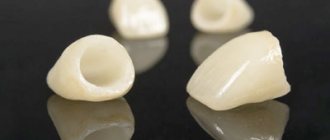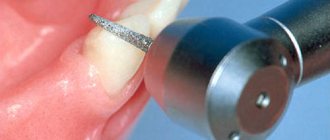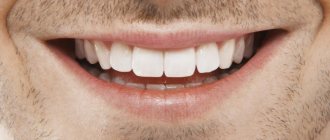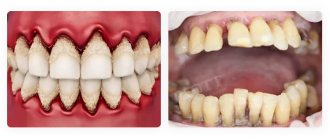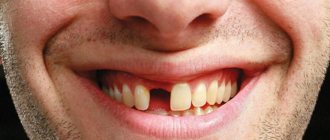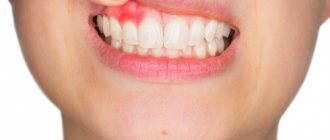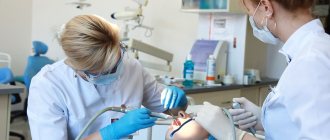A beautiful smile undoubtedly matters to a person. After all, this is what many people fix their attention on when they meet. A smile leaves an unforgettable impression on the interlocutor. It plays an important role in your confidence when communicating. A beautiful smile will improve contact with your interlocutor, improve behavior and leave behind all sorrows and self-doubt, and will also melt the heart of any stranger. But if the smile is not perfect and there is a defect in the front teeth (cracked dental plate, extracted tooth, crooked bite or tooth fragment, caries), how can we talk about self-confidence? Such a person will become isolated from others, become withdrawn, stop smiling, and will feel awkward when communicating. All this can leave a mark on a person’s profession and on his personal life.
No one wants to show problems with their front teeth to others, so dentures are the best solution for such patients.
When performing prosthetics after removal, it is important to restore and preserve the functions of the organ:
- Correct bite;
- Shape;
- Natural color;
- Gum health.
Prosthetics of the front teeth is also an aesthetic issue, therefore, to create a beautiful smile, it is necessary to use high-quality, durable materials that will visually look good. In dentistry, several methods of installing dentures are used and leading materials are used to give each patient a dazzling smile.
The main indications for the use of anterior dental prostheses are:
- Cracks in the dental plate, chips, broken teeth;
- Lost teeth or congenital adentia;
- Carious teeth;
- Crooked bite;
- Yellowing or darkening of the enamel;
- Crooked teeth, irregular shape and uneven “facial” surface of the tooth;
- Early unsuccessful prosthetics.
To solve your problem and select the correct method for installing dentures after removing your front teeth, you can consult the Dr. Levin dental clinic by calling the clinic.
Prosthetic options for anterior teeth
- Temporary and permanent;
- Removable and non-removable.
Temporary prostheses are needed for emergency filling of the defect. This option is performed for a broken tooth, extraction, and when removing or replacing other dentures. To do this, temporary plastic prostheses or removable dentures are used to close the existing defect. The wearing period of such implants is 30-60 days. This time will be enough to make a permanent prosthesis and sanitize the oral cavity.
Permanent prosthetics are performed after the root implant has healed, with healthy neighboring teeth, and in the absence of inflammatory changes in the oral cavity.
Removable prosthetics can be used in people who, due to contraindications, cannot currently perform such a procedure and it is postponed for some time. Or when it is not possible to install a prosthetic bridge due to the lack of more than four teeth in a row or the supporting teeth are damaged. Such patients are recommended to wear removable dentures.
Fixed prosthetics are carried out according to indications and include the following techniques:
- Implantation;
- Bridge prosthetics;
- Installation of crowns;
- Installation of veneers or lumineers.
There are several options for prosthetics of the upper and lower front teeth
Price
- Primary appointment (examination, consultation) with a dentist (special offer) 100001
For free
Promotion
- Tooth restoration with inlay (E.max) 152012
19 900 ₽
- Tooth restoration with a full zirconium crown 152015
13 900 ₽
- Tooth restoration with a metal-ceramic crown 152019
13 900 ₽
- Prosthetics with partial removable lamellar dentures (up to 3 teeth) 153001
9 900 ₽
- Manufacturing of removable dentures from thermoplastic material (up to 3 teeth) 153004
15 000 ₽
- SGS implant + turnkey crown
24 900 ₽
Promotion
Prosthetics of chewing teeth are measures aimed at restoring the lateral sections of the upper or lower row, as well as the functions of the distant teeth (molars and premolars). The method is chosen taking into account the size, location, defect, as well as the health status and personal interests of the patient. Prosthetics are carried out using removable or non-removable orthopedic structures, as well as by implantation. The latter option ensures the restoration of the functions of lost crowns and roots, and is therefore the most physiological.
Implantation of artificial teeth
A modern, long-lasting option for the restoration of front teeth is implantation. This operation involves inserting a special pin into the jaw bone, in the place where a tooth is missing, which will act as a tooth root and will counteract atrophic changes in bone tissue. This pin is made of titanium and does not cause any inconvenience or complications in the future. Then a crown made of ceramic is installed on this titanium rod. Implantation makes it possible not to touch the healthy teeth in the neighborhood. For this procedure, high-quality durable implants from the Nobel Biocare brand are used, which are guaranteed for life. The implanted tooth will not differ in any way from the rest, since the crown is made after measurement and exactly matches the shape and natural shade of the teeth. Another technique for using dentures on the front teeth is installing a bridge.
The name “bridge” was borrowed from technicians, since its installation uses the principle of constructing bridges. A bridge is a type of permanent dental prosthesis; they are used to replace defects of several teeth (up to four) in a row. To do this, special crowns are installed on the adjacent good teeth, between which the prosthesis will be placed. The negative quality of this technique is the need to grind down the surface and remove the pulp of healthy teeth on which crowns will be placed. The bridge also needs to be replaced at least once every few years. But with these disadvantages, this method allows you to avoid surgical intervention.
What kind of prosthesis can be placed if there are no back molars?
Dental bridge
Fixed bridge prosthetics involves installing an integral structure of several metal-ceramic or zirconium crowns on the patient’s own teeth. The central part of the product compensates for the defect, and the side parts distribute the load on the supports.
To replace a missing molar, you need to fix the bridge on at least 2 chewing teeth on both sides. The supports are subjected to preparation (turning, depulping, strengthening with pins or inlays). The orthopedic structure is installed using cement and cannot be removed (without damage). The method is used in the absence of 1-3 teeth. Do not use for terminal defects or unsatisfactory condition of supports. Extended bridges cannot be installed in the bending area of a row due to the risk of breakage.
The advantages of prosthetic bridges are aesthetics, good fixation, and a minimum of contraindications. But preparation of supporting molars and increased load accelerate their wear. Atrophic changes in the bone lead to subsidence of the soft tissues under the central part of the bridge. The displacement and destruction of supporting teeth contributes to a gradual increase in the defect. As a result, the patient will have to choose another method of prosthetics.
Removable dentures
If the patient does not have several chewing teeth, the defects are located at the ends or on both sides of the row, they resort to prosthetics with removable orthopedic structures. Partial dentures can be installed or removed independently for cleaning or while sleeping. The following types are used in our dentistry:
- Plastic (acrylic). Acrylic structures can include from 1 to 12 crowns. Extended dentures for the lower row are fixed only on soft tissues. Products for the upper row are attached to the hard palate using a plate. Short designs for 1-2 crowns are fixed on hooks for the lateral teeth. Pros: price, quick production. The disadvantages of removable plastic products are poor fixation, instability to loads, absorption of dyes and odors, and the risk of developing allergies.
- Akri fries. Monomer-free plastic is more flexible than acrylic. It is used to make hinged dentures of any length. The elasticity of the material makes it possible to reduce the size of the structure. Translucent hooks for fixation are not visible in the smile area. Orthopedic devices made from Acree Free are more convenient to use and do not cause allergies, but they cost more than classic ones.
- Nylon. The material imitates the mucous membrane well and attaches better to soft tissues. However, nylon quickly stretches, becomes deformed, changes color and smell, and transfers the chewing load to the gums, which is accompanied by pain.
- Quattro Ti. The material combines the properties of plastic and nylon. Partial dentures of compact sizes are made from it. The device is attached to soft tissue. Additional fixation is provided by transparent hooks (clasps). Devices for the upper jaw have almost no palatal overlap, which facilitates adaptation and eliminates distortion of taste perception.
- Bugelnye. The device has a solid base in the form of a metal arch, is equipped with artificial gums and crowns, as well as metal or plastic clasps. The device is well fixed and distributes the chewing load. Orthopedic products of the clasp type are recognized as optimal for removable prosthetics. Disadvantages - the price is higher, dentures with metal hooks in the frontal area are visible to others.
Removable structures do not stop bone tissue atrophy. The alveolar ridge sags, which negatively affects the quality of fixation. Such devices need to be repositioned as the contours of the prosthetic bed change. You need to get used to the orthopedic device. Large structures interfere with diction, cause excessive salivation, and chafe the gums. Sometimes palatal occlusion provokes a persistent gag reflex.
Crowns or bridges on implants
Implantation is recognized as the most effective and physiological way to restore the row. The method involves the introduction of titanium implants into the jawbone and subsequent fixation of crowns or dental bridges on them. Provides prosthetics for the invisible root part and visible coronal part. Used to eliminate isolated and multiple defects, as well as in cases of complete edentia.
The main advantage of implantation is the restoration of lost units entirely. The method ensures the transfer of chewing load to bone tissue, which prevents atrophic changes, the development of malocclusions, and premature aging. The patient does not experience the sensation of a foreign body in the mouth and after the implants have been implanted, they can eat any food. Implant systems last from 10 years. When using quality materials, the results last a lifetime.
Prosthetics of anterior teeth using crowns
Sometimes lesions on the front teeth can be more serious. Then prosthetics of the front teeth using crowns is suitable. To make the most natural shape of the tooth being installed and to ensure a tight fit of the crown, it is necessary to grind the affected tooth and, if necessary, remove the pulp and nerve. Then process and seal the canals. After fitting, a ceramic crown is installed on the dental cement mortar. Ceramic or zirconium structures without metal are best suited for dental prosthetics.
The main advantages of such crowns are:
- The base from which the dentures are made must be hypoallergenic. Which is very important. Ceramic crowns do not cause allergic reactions.
- Ceramic crowns look aesthetically pleasing. Based on individual measurements and subsequent fitting, you can ideally select the desired shape and color that will match the natural shade of natural teeth.
- Metal-free crowns do not cause darkening of the gums around the installed tooth and do not leave a metal rim. They also do not lead to alveolitis, gingivitis and periodontitis.
- Ceramic crowns will not cause discomfort when eating food at different temperatures.
- Also, such crowns are lightweight, comfortable and durable.
Crowns: what are they?
Depending on the composition they have indications and contraindications. Many people wonder how they are made and what they consist of dentures and their parts. Let's look at each type separately.
Metal
There are cast and stamped. They are widespread due to their low cost, as well as ease of implantation and maintenance, but have lost their relevance due to the use of more modern analogues.
They can be made of nickel, titanium, gold, silver, cobalt. The downside is complete unattractiveness.
Plastic
They are made with or without a finished frame. Attractive and beautiful design, together with simple and cheap installation, can make them leaders in application. Low strength and fragility are the main disadvantages of polymer dentures and structures. In addition, plastic is a highly allergenic component.
Used for restoration, correction of anterior incisors (low load) and temporary solutions, while a permanent option is in development.
Metal-ceramic
Metal base, in the upper layers of which a ceramic coating is applied. The most common: ideal price-quality ratio. Strength, durability, the ability to be inserted into any place are advantages. The disadvantages include a possible change in color over time (requires additional care and protection), may be rejected or lead to inflammation of the gums.
Porcelain
Porcelain implants are made using press casting followed by firing. Aesthetic, strong and durable, while completely anti-allergenic. However, the high price threshold greatly reduces the application.
Zirconium dioxide crowns
After smelting, they are able to completely copy the natural external structure of the teeth. The high cost and the impossibility of subsequent adjustments after smelting the structure make this material rare. However, high strength and durability are its advantages.
Prosthetic replacement of anterior tooth after extraction
After tooth extraction, it is better to do its prosthetics using the express implantation technique, in the absence of contraindications. To do this, immediately after tooth extraction, an implant and a special abutment are installed in its alveolar socket to form the correct gum shape. A crown is temporarily placed on it. After the implant has healed for approximately several months, a permanent crown is installed.
The advantages of express implantation include:
- This procedure does not require any additional incisions, which is less traumatic to the gums;
- The implant is installed in an open manner, which also does not require additional surgical intervention;
- This method is perfect for patients who do not want to wait until the hole heals and a bridge or crown can be installed.
- Short healing period;
- There are few side complications that are unpleasant for the patient.
Installation of dentures for anterior teeth without turning
This is the restoration of damaged teeth, when the neighboring teeth intended for support are not ground down or depulped. In this case, it is worth performing implantation. This is one of the most gentle and atraumatic methods of installing upper and lower teeth. The essence of the method is that in the place of the lost tooth, an implant is installed in the jaw bone tissue, which performs the function of a root. Subsequently, a crown is put on it.
There are also methods that do not require grinding of a layer of healthy teeth, but they are rather temporary.
Types of dentures, if the root remains
- Tabs. In case of partial destruction of only the upper part of the tooth, the microprosthetic method is used. The defect is filled with a ceramic inlay made from an impression. The product restores the anatomical shape. The inlay is stronger than a composite filling and is resistant to chewing loads. Used when the crown is destroyed by 25-50%.
- Crowns. If there is significant destruction of the supragingival part of the tooth (more than half), prosthetics with crowns are performed. The root is first strengthened with a stump tab. It is better not to place metal-plastic or ceramic crowns on your back teeth. The fragile material cannot withstand the stress of chewing food. It is better to install more durable products made of metal ceramics or zirconium dioxide in the lateral sections of the jaw. Zirconium is more physiological and hypoallergenic. In our clinic, they do not differ in cost from metal-ceramic ones due to production in our own dental laboratory.
Veneers and Lumineers
Veneers and lumineers can be used as aesthetic options for dentures on the front teeth. Veneers are very thin shells of porcelain that are given a color similar to the natural color of the patient's teeth. Veneers completely match the shape of a natural tooth. Such plates are attached to the front surface of the tooth.
Lumineers are transparent and very thin plates about 0.15 mm thick. Placed on the front surface of the tooth. This cosmetic procedure is non-invasive, quick, painless and long lasting.
These qualities determine the indications for the installation of veneers or lumineers:
- Crack and small chip of a tooth;
- Yellowing or darkening of tooth enamel;
- Uneven frontal surface;
- Crooked teeth.
Installation of prosthetic anterior teeth on the upper and lower jaws
The use of dentures for the lower and upper anterior teeth is almost the same from a practical point of view. The difference may lie in the fact that the installation of dentures for the upper teeth requires more attention from the dentist, since the upper jaw is somewhat less well supplied with blood than the lower jaw, hence healing here will take a little longer. And also, when a person smiles, the front teeth are the first to be seen from above, so it is necessary to pay more attention to the aesthetic side of prosthetics.
Preparing for dental prosthetics
Many people do not like any dental procedures, and this is due to the fear of unbearable pain. You should not be afraid of dental prosthetics, since the most unpleasant thing you will encounter is tooth grinding and depulpation. And all procedures are carried out using local, good, strong anesthetics.
An important diagnostic point is x-ray examination to determine the number and size of roots.
Other stages of preparation include the improvement of neighboring teeth (removal of plaque, treatment of carious damage), which will serve as a support for the prosthesis. If the tooth is significantly damaged, they resort to extraction, treatment of the canals and their subsequent filling.
For prosthetic treatment of anterior teeth, as for any other manipulation, there are contraindications. They are divided into absolute and relative.
Absolute contraindications include:
- 3-4 stages of cancer;
- Conditions after chemotherapy;
- Immunodeficiency conditions;
- Severe somatic diseases in the stage of decompensated state;
Relative:
- Diabetes mellitus (especially type 1);
- Diseases of the heart and blood vessels, such as hypertension with crisis and angina pectoris;
- Smoking, alcoholism;
- Mental disorders;
- Pregnancy;
- Allergic reactions to dental medications and materials.
When is a crown placed on a living tooth?
The quality of endodontic treatment, which is carried out before dental prosthetics, largely depends on the presence or absence of pulp. In most cases, it is depulpation that allows all manipulations to be carried out more thoroughly, which significantly reduces the risk of any complications.
Treatment and installation of a crown on a living tooth requires local anesthesia. This method is performed extremely rarely, and the decision is made on an individual basis. This takes into account the level of tooth decay and the material used to make the crown. It is recommended to install only a zirconium crown or half-crown (like a veneer) on a living chewing tooth.
